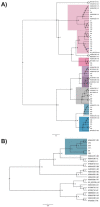Genetic Variability in the E6, E7, and L1 Genes of Human Papillomavirus Types 16 and 18 among Women in Saudi Arabia
- PMID: 36680149
- PMCID: PMC9862970
- DOI: 10.3390/v15010109
Genetic Variability in the E6, E7, and L1 Genes of Human Papillomavirus Types 16 and 18 among Women in Saudi Arabia
Abstract
Cervical cancer is the eighth most frequent cancer in Saudi Arabia, and most cases are associated with human papillomavirus (HPV) types 16 and 18. HPV-induced carcinogenesis may be associated with the intra-type variant, genetic mutation, or the continuous expression of viral oncogenes E6 and E7. Infection efficiency and virus antigenicity may be affected by changes in the L1 gene. Thus, this retrospective cohort study analyzed E6, E7, and L1 gene mutations in cervical specimens collected from Saudi women positive for HPV16 or HPV18 infection. HPV16 and HPV18 lineages in these specimens were predominantly from Europe. The L83V mutation in the E6 gene of HPV16 showed sufficient oncogenic potential for progression to cervical cancer. By contrast, the L28F mutation in the E7 gene of HPV16 was associated with a low risk of cervical cancer. Other specific HPV16 and HPV18 mutations were associated with an increased risk of cancer, cancer progression, viral load, and age. Four novel mutations, K53T, K53N, R365P, and K443N, were identified in the L1 gene of HPV16. These findings for HPV16 and HPV18 lineages and mutations in the E6, E7, and L1 genes among women in Saudi Arabia may inform the design and development of effective molecular diagnostic tests and vaccination strategies for the Saudi population.
Keywords: E6 gene; E7 gene; HPV16; HPV18; L1 gene; cancer progression; cervical cancer; lineages; mutations; variants.
Conflict of interest statement
The authors declare no conflict of interest.
Figures




Similar articles
-
Development of DNA Vaccine Targeting E6 and E7 Proteins of Human Papillomavirus 16 (HPV16) and HPV18 for Immunotherapy in Combination with Recombinant Vaccinia Boost and PD-1 Antibody.mBio. 2021 Jan 19;12(1):e03224-20. doi: 10.1128/mBio.03224-20. mBio. 2021. PMID: 33468698 Free PMC article.
-
Human papillomavirus type 16 E6 and E7 gene variations associated with cervical cancer in a Han Chinese population.Infect Genet Evol. 2019 Sep;73:13-20. doi: 10.1016/j.meegid.2019.04.008. Epub 2019 Apr 11. Infect Genet Evol. 2019. PMID: 30981880
-
Distribution of human papillomavirus among Vietnamese women with cervical cancer and unusual genetic variability of HPV16.Virology. 2024 Jun;594:110058. doi: 10.1016/j.virol.2024.110058. Epub 2024 Mar 16. Virology. 2024. PMID: 38520797
-
Usefulness of high-risk HPV early oncoprotein (E6 and E7) serological markers in the detection of cervical cancer: A systematic review and meta-analysis.J Med Virol. 2023 Jan;95(1):e27900. doi: 10.1002/jmv.27900. Epub 2022 Jun 9. J Med Virol. 2023. PMID: 35641882 Free PMC article.
-
High-Risk Human Papillomavirus Oncogenic E6/E7 mRNAs Splicing Regulation.Front Cell Infect Microbiol. 2022 Jun 27;12:929666. doi: 10.3389/fcimb.2022.929666. eCollection 2022. Front Cell Infect Microbiol. 2022. PMID: 35832386 Free PMC article. Review.
Cited by
-
Genetic variability of human papillomavirus type 18 based on E6, E7 and L1 genes in central China.Virol J. 2024 Jul 5;21(1):152. doi: 10.1186/s12985-024-02424-9. Virol J. 2024. PMID: 38970084 Free PMC article.
References
-
- Hausen H. Zur Human papillomavirus & cervical cancer. Indian J. Med. Res. 2009;130:209. - PubMed
Publication types
MeSH terms
Substances
LinkOut - more resources
Full Text Sources
Medical

